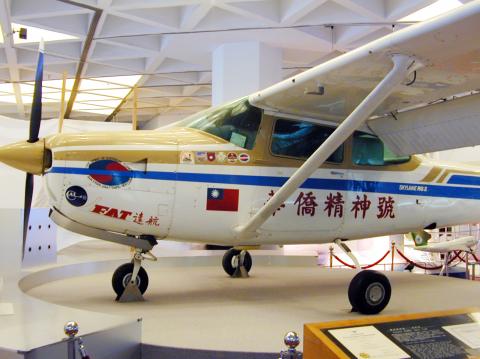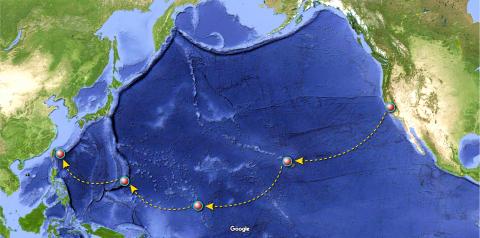Taiwan in Time: July 18 to July 24
In early July of 1984, Jerry Tsai (蔡雲輔) found himself temporarily stranded on Saipan in the Northern Mariana Islands. His problem-riddled bid to become the first person to cross the Pacific in a small single-engine plane (under 1,750kg) suffered another mishap when the tires of his Cessna 182RG blew out while landing, damaging its nose and propeller.
But Tsai vowed not to give up. It took three weeks to fix his plane, and he set out on the last leg of his journey of about 13,500km. His destination: Taiwan.

Photo: Luo Cheng-ming, Taipei Times
Not much is known about Tsai’s early life, except that he had lived in San Francisco for decades by the time of his journey. A former boxing champion, Tsai had sailed solo to the Caribbean and also held a diving license.
Referring to himself as an “adventurer,” Tsai discusses his life philosophy with Taiwanese writer Yu Li-ching (喻麗清) in her book, Follow the Green Line (沿著綠線走).
“Compared to the freedom of flying, what is there to fear about death?” he says. “I believe that this is not limited to physical flight. It can be the flight of thought, or flight of the soul.”

Courtesy of Google Maps
This was back when it was not politically acceptable to distinguish Taiwanese and Chinese, thus there is no clear indication of Tsai’s origin of birth. US newspapers either referred to him as American or Chinese-American, but he seemed to resent the racial discrimination against Asians in the US and clearly had something to prove.
Nevertheless, Tsai’s journey was seen as a source of pride for the people and government of Taiwan back then, and he said that wanted to accomplish this feat for the glory of the “motherland.”
Tsai’s tells his story in a first-person account in Biographies of Overseas Chinese (世界華僑名人傳), edited by Yang Ching-nan (楊慶南).
On June 18, 1984, Tsai announced to the world his plans to depart from San Francisco for Taipei in the Cessna named Spirit of Overseas Chinese (華僑精神號), making stops in Honolulu, Majuro and Saipan. During his test run from San Francisco to San Diego, he broke the world record for speed over a recognized course for planes between 1,000kg and 1750kg — which has been superseded since.
As Tsai was waiting to depart, he recalled hearing over the VHF radio other pilots’ disbelief about him trying to fly such a tiny aircraft across the Pacific.
“Over the past year, everybody has called me crazy — even my wife,” he writes.
Yang writes in the commentary on Tsai’s voyage about how dangerous the flight was: “This type of single engine small plane is very easily affected by the climate. It also carries limited fuel, and if blown off course, might not have enough to reach its destination. Small aircraft are also not well-adapted for turbulence and storms. Also, the altitude limitations of these aircraft make communication more difficult, and the small plane body can only carry limited emergency equipment.”
Yang adds that this flight definitely would not have been sanctioned in Taiwan, but that the Americans respected one’s personal freedom to embark on an adventure.
Tsai did not seem very well-prepared — he even admits in Yu’s book that his plane was not meant for long-distance travel. In case he had to land in the ocean, he only brought a makeshift raft made of 5,000 ping pong balls and a knife to fend off sharks.
The first leg of the flight went smoothly, but Tsai spent a few days in Honolulu repairing his VHF radio. It malfunctioned again as he headed toward Majuro, and he had to use a radio with a range of only 40 miles for the next 13 hours.
Tsai made it to Majuro but now faced a dilemma. His long-range radio and navigation equipment were broken, and he had to decide whether to carry on. He decided on dead reckoning, which is when one flies by manually determining the aircraft’s position and course.
“I opened my map and marked the three islands of Bucholz, Ponape and Truk as the coordinates for dead reckoning. Then, full of confidence, I closed the hatch and headed to Saipan,” he writes.
Tsai writes that the crash landing in Saipan was the saddest event of his life. But luckily, people in Taiwan were closely following his flight and more than eager to help.
Far Eastern Transport (遠東航空) first announced that it would send three technicians to Saipan. Two days later, the United World Chinese Commercial Bank (世華聯合商業銀行) donated about NT$320,000 to the repair costs. Another two days later, the now-defunct Yung Shing Airlines (永興航空) also dispatched the head of its mechanical department to the Pacific island as a consultant.
The plane was in flying shape again on July 16, and took off two days later. It landed at Hualien Airport around 3pm on July 19, and after inspections landed safely in Songshan Airport at 5:46pm to great fanfare.
Tsai was personally greeted by then-president Chiang Ching-kuo (蔣經國) and gave the plane to the Chung Cheng Aviation Museum, where it remained on display until its closure in 2014. It is now located at the Taoyuan Naval base.
Taiwan in Time, a column about Taiwan’s history that is published every Sunday, spotlights important or interesting events around the nation that have anniversaries this week.

On April 26, The Lancet published a letter from two doctors at Taichung-based China Medical University Hospital (CMUH) warning that “Taiwan’s Health Care System is on the Brink of Collapse.” The authors said that “Years of policy inaction and mismanagement of resources have led to the National Health Insurance system operating under unsustainable conditions.” The pushback was immediate. Errors in the paper were quickly identified and publicized, to discredit the authors (the hospital apologized). CNA reported that CMUH said the letter described Taiwan in 2021 as having 62 nurses per 10,000 people, when the correct number was 78 nurses per 10,000

May 5 to May 11 What started out as friction between Taiwanese students at Taichung First High School and a Japanese head cook escalated dramatically over the first two weeks of May 1927. It began on April 30 when the cook’s wife knew that lotus starch used in that night’s dinner had rat feces in it, but failed to inform staff until the meal was already prepared. The students believed that her silence was intentional, and filed a complaint. The school’s Japanese administrators sided with the cook’s family, dismissing the students as troublemakers and clamping down on their freedoms — with

As Donald Trump’s executive order in March led to the shuttering of Voice of America (VOA) — the global broadcaster whose roots date back to the fight against Nazi propaganda — he quickly attracted support from figures not used to aligning themselves with any US administration. Trump had ordered the US Agency for Global Media, the federal agency that funds VOA and other groups promoting independent journalism overseas, to be “eliminated to the maximum extent consistent with applicable law.” The decision suddenly halted programming in 49 languages to more than 425 million people. In Moscow, Margarita Simonyan, the hardline editor-in-chief of the

Six weeks before I embarked on a research mission in Kyoto, I was sitting alone at a bar counter in Melbourne. Next to me, a woman was bragging loudly to a friend: She, too, was heading to Kyoto, I quickly discerned. Except her trip was in four months. And she’d just pulled an all-nighter booking restaurant reservations. As I snooped on the conversation, I broke out in a sweat, panicking because I’d yet to secure a single table. Then I remembered: Eating well in Japan is absolutely not something to lose sleep over. It’s true that the best-known institutions book up faster